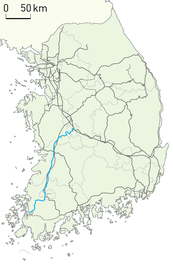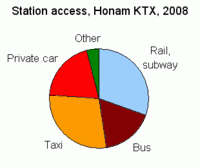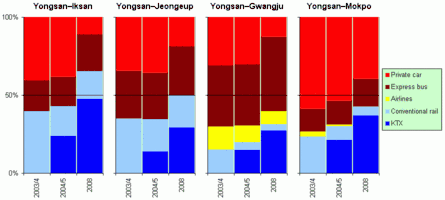Honam Line
The Honam Line is a major railway line serving the Honam region (North and South Jeolla Provinces) in South Korea. The line is served by frequent passenger trains from Seoul (via the Gyeongbu Line) to Gwangju and Mokpo.
| Honam Line | |||||||||||||||||||||||||||||||||||||||||||||||||||||||||||||||||||||||||||||||||||||||||||||||||||||||||||||||||||||||||||||||||||||||||||||||||||||||||||||||||||||||||||||||||||||||||||||||||||||||||||||||||||||||||||||||||||||||||||||||||||||||||||||||||||||||||||||||||||||||||||||||||||||||||||||||||||||||||||||||||||||||||||||||||||||||||||||||||||||||||||||||||||||||||||||||||||||||||||||||||||||||||||||||||||||||||||||||||||||||||||||||||||||||||||||||||||||||||||||||||||||||||||||||||||||||||||||||||||||||||||||||||||||||||||||||||||||||||||||||||||||||||||||||||||||||||||||||||||||||||||||||||||||||||||||||||||||||||||||||||||||||||||||||||||||||||||||||||||||||||||||||||||||||||||||||||||||||||||||||||||||||||||||||||||||||||||||||||||||||||||||||||||||||||||||||||||||||||||||||||||||||||||||||||||||||||||||||||||||||||||||||||||||||||||||||||||||||||||||||||||||||||||||||||||||||||||||||||||||||||||||||||||||||||||||||||||||||||||||||||||||||||||||||||||||||||||||||||||||||
|---|---|---|---|---|---|---|---|---|---|---|---|---|---|---|---|---|---|---|---|---|---|---|---|---|---|---|---|---|---|---|---|---|---|---|---|---|---|---|---|---|---|---|---|---|---|---|---|---|---|---|---|---|---|---|---|---|---|---|---|---|---|---|---|---|---|---|---|---|---|---|---|---|---|---|---|---|---|---|---|---|---|---|---|---|---|---|---|---|---|---|---|---|---|---|---|---|---|---|---|---|---|---|---|---|---|---|---|---|---|---|---|---|---|---|---|---|---|---|---|---|---|---|---|---|---|---|---|---|---|---|---|---|---|---|---|---|---|---|---|---|---|---|---|---|---|---|---|---|---|---|---|---|---|---|---|---|---|---|---|---|---|---|---|---|---|---|---|---|---|---|---|---|---|---|---|---|---|---|---|---|---|---|---|---|---|---|---|---|---|---|---|---|---|---|---|---|---|---|---|---|---|---|---|---|---|---|---|---|---|---|---|---|---|---|---|---|---|---|---|---|---|---|---|---|---|---|---|---|---|---|---|---|---|---|---|---|---|---|---|---|---|---|---|---|---|---|---|---|---|---|---|---|---|---|---|---|---|---|---|---|---|---|---|---|---|---|---|---|---|---|---|---|---|---|---|---|---|---|---|---|---|---|---|---|---|---|---|---|---|---|---|---|---|---|---|---|---|---|---|---|---|---|---|---|---|---|---|---|---|---|---|---|---|---|---|---|---|---|---|---|---|---|---|---|---|---|---|---|---|---|---|---|---|---|---|---|---|---|---|---|---|---|---|---|---|---|---|---|---|---|---|---|---|---|---|---|---|---|---|---|---|---|---|---|---|---|---|---|---|---|---|---|---|---|---|---|---|---|---|---|---|---|---|---|---|---|---|---|---|---|---|---|---|---|---|---|---|---|---|---|---|---|---|---|---|---|---|---|---|---|---|---|---|---|---|---|---|---|---|---|---|---|---|---|---|---|---|---|---|---|---|---|---|---|---|---|---|---|---|---|---|---|---|---|---|---|---|---|---|---|---|---|---|---|---|---|---|---|---|---|---|---|---|---|---|---|---|---|---|---|---|---|---|---|---|---|---|---|---|---|---|---|---|---|---|---|---|---|---|---|---|---|---|---|---|---|---|---|---|---|---|---|---|---|---|---|---|---|---|---|---|---|---|---|---|---|---|---|---|---|---|---|---|---|---|---|---|---|---|---|---|---|---|---|---|---|---|---|---|---|---|---|---|---|---|---|---|---|---|---|---|---|---|---|---|---|---|---|---|---|---|---|---|---|---|---|---|---|---|---|---|---|---|---|---|---|---|---|---|---|---|---|---|---|---|---|---|---|---|---|---|---|---|---|---|---|---|---|---|---|---|---|---|---|---|---|---|---|---|---|---|---|---|---|---|---|---|---|---|---|---|---|---|---|---|---|---|---|---|---|---|---|---|---|---|---|---|---|---|---|---|---|---|---|---|---|---|---|---|---|---|---|---|---|---|---|---|---|---|---|---|---|---|---|---|---|---|---|---|---|---|---|---|---|---|---|---|---|---|---|---|---|---|---|---|---|---|---|---|---|---|---|---|---|---|---|---|---|---|---|---|---|---|---|---|---|---|---|---|---|---|---|---|---|---|---|---|---|---|---|---|---|---|---|---|---|---|---|---|---|---|---|---|---|---|---|---|---|---|---|---|---|---|---|---|---|---|---|---|---|---|---|---|---|---|---|---|---|---|---|---|---|---|---|---|---|---|---|---|---|---|---|---|---|---|---|---|---|---|---|---|---|---|---|---|---|---|---|---|---|---|---|---|---|---|---|---|---|---|---|---|---|---|---|---|---|---|---|---|---|---|---|---|---|---|---|---|---|---|---|---|---|---|---|---|---|---|---|---|---|---|---|---|---|---|---|---|---|---|---|---|---|---|---|---|---|---|---|---|---|---|---|---|---|---|---|---|---|---|---|---|---|---|---|---|---|---|---|---|---|---|---|---|---|---|---|---|---|---|---|---|---|---|---|---|---|---|---|---|---|---|---|---|---|---|---|---|---|---|---|---|---|---|---|---|---|---|---|---|---|---|---|---|---|---|---|---|---|---|---|---|---|---|---|---|---|---|---|---|---|---|---|---|---|---|---|---|---|---|---|---|---|---|---|---|---|---|---|---|---|---|---|---|---|---|---|---|---|---|---|---|---|---|---|---|---|---|---|---|---|---|---|---|---|---|---|---|---|---|---|---|---|---|---|---|---|---|---|---|---|---|---|---|---|---|---|---|---|---|
 | |||||||||||||||||||||||||||||||||||||||||||||||||||||||||||||||||||||||||||||||||||||||||||||||||||||||||||||||||||||||||||||||||||||||||||||||||||||||||||||||||||||||||||||||||||||||||||||||||||||||||||||||||||||||||||||||||||||||||||||||||||||||||||||||||||||||||||||||||||||||||||||||||||||||||||||||||||||||||||||||||||||||||||||||||||||||||||||||||||||||||||||||||||||||||||||||||||||||||||||||||||||||||||||||||||||||||||||||||||||||||||||||||||||||||||||||||||||||||||||||||||||||||||||||||||||||||||||||||||||||||||||||||||||||||||||||||||||||||||||||||||||||||||||||||||||||||||||||||||||||||||||||||||||||||||||||||||||||||||||||||||||||||||||||||||||||||||||||||||||||||||||||||||||||||||||||||||||||||||||||||||||||||||||||||||||||||||||||||||||||||||||||||||||||||||||||||||||||||||||||||||||||||||||||||||||||||||||||||||||||||||||||||||||||||||||||||||||||||||||||||||||||||||||||||||||||||||||||||||||||||||||||||||||||||||||||||||||||||||||||||||||||||||||||||||||||||||||||||||||||
| Overview | |||||||||||||||||||||||||||||||||||||||||||||||||||||||||||||||||||||||||||||||||||||||||||||||||||||||||||||||||||||||||||||||||||||||||||||||||||||||||||||||||||||||||||||||||||||||||||||||||||||||||||||||||||||||||||||||||||||||||||||||||||||||||||||||||||||||||||||||||||||||||||||||||||||||||||||||||||||||||||||||||||||||||||||||||||||||||||||||||||||||||||||||||||||||||||||||||||||||||||||||||||||||||||||||||||||||||||||||||||||||||||||||||||||||||||||||||||||||||||||||||||||||||||||||||||||||||||||||||||||||||||||||||||||||||||||||||||||||||||||||||||||||||||||||||||||||||||||||||||||||||||||||||||||||||||||||||||||||||||||||||||||||||||||||||||||||||||||||||||||||||||||||||||||||||||||||||||||||||||||||||||||||||||||||||||||||||||||||||||||||||||||||||||||||||||||||||||||||||||||||||||||||||||||||||||||||||||||||||||||||||||||||||||||||||||||||||||||||||||||||||||||||||||||||||||||||||||||||||||||||||||||||||||||||||||||||||||||||||||||||||||||||||||||||||||||||||||||||||||||||
| Native name | 호남선(湖南線) | ||||||||||||||||||||||||||||||||||||||||||||||||||||||||||||||||||||||||||||||||||||||||||||||||||||||||||||||||||||||||||||||||||||||||||||||||||||||||||||||||||||||||||||||||||||||||||||||||||||||||||||||||||||||||||||||||||||||||||||||||||||||||||||||||||||||||||||||||||||||||||||||||||||||||||||||||||||||||||||||||||||||||||||||||||||||||||||||||||||||||||||||||||||||||||||||||||||||||||||||||||||||||||||||||||||||||||||||||||||||||||||||||||||||||||||||||||||||||||||||||||||||||||||||||||||||||||||||||||||||||||||||||||||||||||||||||||||||||||||||||||||||||||||||||||||||||||||||||||||||||||||||||||||||||||||||||||||||||||||||||||||||||||||||||||||||||||||||||||||||||||||||||||||||||||||||||||||||||||||||||||||||||||||||||||||||||||||||||||||||||||||||||||||||||||||||||||||||||||||||||||||||||||||||||||||||||||||||||||||||||||||||||||||||||||||||||||||||||||||||||||||||||||||||||||||||||||||||||||||||||||||||||||||||||||||||||||||||||||||||||||||||||||||||||||||||||||||||||||||||
| Type | Heavy Rail, Passenger/freight rail Regional rail, Intercity rail | ||||||||||||||||||||||||||||||||||||||||||||||||||||||||||||||||||||||||||||||||||||||||||||||||||||||||||||||||||||||||||||||||||||||||||||||||||||||||||||||||||||||||||||||||||||||||||||||||||||||||||||||||||||||||||||||||||||||||||||||||||||||||||||||||||||||||||||||||||||||||||||||||||||||||||||||||||||||||||||||||||||||||||||||||||||||||||||||||||||||||||||||||||||||||||||||||||||||||||||||||||||||||||||||||||||||||||||||||||||||||||||||||||||||||||||||||||||||||||||||||||||||||||||||||||||||||||||||||||||||||||||||||||||||||||||||||||||||||||||||||||||||||||||||||||||||||||||||||||||||||||||||||||||||||||||||||||||||||||||||||||||||||||||||||||||||||||||||||||||||||||||||||||||||||||||||||||||||||||||||||||||||||||||||||||||||||||||||||||||||||||||||||||||||||||||||||||||||||||||||||||||||||||||||||||||||||||||||||||||||||||||||||||||||||||||||||||||||||||||||||||||||||||||||||||||||||||||||||||||||||||||||||||||||||||||||||||||||||||||||||||||||||||||||||||||||||||||||||||||||
| Status | Operational | ||||||||||||||||||||||||||||||||||||||||||||||||||||||||||||||||||||||||||||||||||||||||||||||||||||||||||||||||||||||||||||||||||||||||||||||||||||||||||||||||||||||||||||||||||||||||||||||||||||||||||||||||||||||||||||||||||||||||||||||||||||||||||||||||||||||||||||||||||||||||||||||||||||||||||||||||||||||||||||||||||||||||||||||||||||||||||||||||||||||||||||||||||||||||||||||||||||||||||||||||||||||||||||||||||||||||||||||||||||||||||||||||||||||||||||||||||||||||||||||||||||||||||||||||||||||||||||||||||||||||||||||||||||||||||||||||||||||||||||||||||||||||||||||||||||||||||||||||||||||||||||||||||||||||||||||||||||||||||||||||||||||||||||||||||||||||||||||||||||||||||||||||||||||||||||||||||||||||||||||||||||||||||||||||||||||||||||||||||||||||||||||||||||||||||||||||||||||||||||||||||||||||||||||||||||||||||||||||||||||||||||||||||||||||||||||||||||||||||||||||||||||||||||||||||||||||||||||||||||||||||||||||||||||||||||||||||||||||||||||||||||||||||||||||||||||||||||||||||||||
| Locale | Daejeon South Chungcheong North Jeolla South Jeolla Gwangju | ||||||||||||||||||||||||||||||||||||||||||||||||||||||||||||||||||||||||||||||||||||||||||||||||||||||||||||||||||||||||||||||||||||||||||||||||||||||||||||||||||||||||||||||||||||||||||||||||||||||||||||||||||||||||||||||||||||||||||||||||||||||||||||||||||||||||||||||||||||||||||||||||||||||||||||||||||||||||||||||||||||||||||||||||||||||||||||||||||||||||||||||||||||||||||||||||||||||||||||||||||||||||||||||||||||||||||||||||||||||||||||||||||||||||||||||||||||||||||||||||||||||||||||||||||||||||||||||||||||||||||||||||||||||||||||||||||||||||||||||||||||||||||||||||||||||||||||||||||||||||||||||||||||||||||||||||||||||||||||||||||||||||||||||||||||||||||||||||||||||||||||||||||||||||||||||||||||||||||||||||||||||||||||||||||||||||||||||||||||||||||||||||||||||||||||||||||||||||||||||||||||||||||||||||||||||||||||||||||||||||||||||||||||||||||||||||||||||||||||||||||||||||||||||||||||||||||||||||||||||||||||||||||||||||||||||||||||||||||||||||||||||||||||||||||||||||||||||||||||||
| Termini | Daejeon Rail yard Mokpo | ||||||||||||||||||||||||||||||||||||||||||||||||||||||||||||||||||||||||||||||||||||||||||||||||||||||||||||||||||||||||||||||||||||||||||||||||||||||||||||||||||||||||||||||||||||||||||||||||||||||||||||||||||||||||||||||||||||||||||||||||||||||||||||||||||||||||||||||||||||||||||||||||||||||||||||||||||||||||||||||||||||||||||||||||||||||||||||||||||||||||||||||||||||||||||||||||||||||||||||||||||||||||||||||||||||||||||||||||||||||||||||||||||||||||||||||||||||||||||||||||||||||||||||||||||||||||||||||||||||||||||||||||||||||||||||||||||||||||||||||||||||||||||||||||||||||||||||||||||||||||||||||||||||||||||||||||||||||||||||||||||||||||||||||||||||||||||||||||||||||||||||||||||||||||||||||||||||||||||||||||||||||||||||||||||||||||||||||||||||||||||||||||||||||||||||||||||||||||||||||||||||||||||||||||||||||||||||||||||||||||||||||||||||||||||||||||||||||||||||||||||||||||||||||||||||||||||||||||||||||||||||||||||||||||||||||||||||||||||||||||||||||||||||||||||||||||||||||||||||||
| Stations | 48 | ||||||||||||||||||||||||||||||||||||||||||||||||||||||||||||||||||||||||||||||||||||||||||||||||||||||||||||||||||||||||||||||||||||||||||||||||||||||||||||||||||||||||||||||||||||||||||||||||||||||||||||||||||||||||||||||||||||||||||||||||||||||||||||||||||||||||||||||||||||||||||||||||||||||||||||||||||||||||||||||||||||||||||||||||||||||||||||||||||||||||||||||||||||||||||||||||||||||||||||||||||||||||||||||||||||||||||||||||||||||||||||||||||||||||||||||||||||||||||||||||||||||||||||||||||||||||||||||||||||||||||||||||||||||||||||||||||||||||||||||||||||||||||||||||||||||||||||||||||||||||||||||||||||||||||||||||||||||||||||||||||||||||||||||||||||||||||||||||||||||||||||||||||||||||||||||||||||||||||||||||||||||||||||||||||||||||||||||||||||||||||||||||||||||||||||||||||||||||||||||||||||||||||||||||||||||||||||||||||||||||||||||||||||||||||||||||||||||||||||||||||||||||||||||||||||||||||||||||||||||||||||||||||||||||||||||||||||||||||||||||||||||||||||||||||||||||||||||||||||||
| Operation | |||||||||||||||||||||||||||||||||||||||||||||||||||||||||||||||||||||||||||||||||||||||||||||||||||||||||||||||||||||||||||||||||||||||||||||||||||||||||||||||||||||||||||||||||||||||||||||||||||||||||||||||||||||||||||||||||||||||||||||||||||||||||||||||||||||||||||||||||||||||||||||||||||||||||||||||||||||||||||||||||||||||||||||||||||||||||||||||||||||||||||||||||||||||||||||||||||||||||||||||||||||||||||||||||||||||||||||||||||||||||||||||||||||||||||||||||||||||||||||||||||||||||||||||||||||||||||||||||||||||||||||||||||||||||||||||||||||||||||||||||||||||||||||||||||||||||||||||||||||||||||||||||||||||||||||||||||||||||||||||||||||||||||||||||||||||||||||||||||||||||||||||||||||||||||||||||||||||||||||||||||||||||||||||||||||||||||||||||||||||||||||||||||||||||||||||||||||||||||||||||||||||||||||||||||||||||||||||||||||||||||||||||||||||||||||||||||||||||||||||||||||||||||||||||||||||||||||||||||||||||||||||||||||||||||||||||||||||||||||||||||||||||||||||||||||||||||||||||||||||
| Opened | Stages between 1911-1914 | ||||||||||||||||||||||||||||||||||||||||||||||||||||||||||||||||||||||||||||||||||||||||||||||||||||||||||||||||||||||||||||||||||||||||||||||||||||||||||||||||||||||||||||||||||||||||||||||||||||||||||||||||||||||||||||||||||||||||||||||||||||||||||||||||||||||||||||||||||||||||||||||||||||||||||||||||||||||||||||||||||||||||||||||||||||||||||||||||||||||||||||||||||||||||||||||||||||||||||||||||||||||||||||||||||||||||||||||||||||||||||||||||||||||||||||||||||||||||||||||||||||||||||||||||||||||||||||||||||||||||||||||||||||||||||||||||||||||||||||||||||||||||||||||||||||||||||||||||||||||||||||||||||||||||||||||||||||||||||||||||||||||||||||||||||||||||||||||||||||||||||||||||||||||||||||||||||||||||||||||||||||||||||||||||||||||||||||||||||||||||||||||||||||||||||||||||||||||||||||||||||||||||||||||||||||||||||||||||||||||||||||||||||||||||||||||||||||||||||||||||||||||||||||||||||||||||||||||||||||||||||||||||||||||||||||||||||||||||||||||||||||||||||||||||||||||||||||||||||||||
| Owner | Korea Rail Network Authority | ||||||||||||||||||||||||||||||||||||||||||||||||||||||||||||||||||||||||||||||||||||||||||||||||||||||||||||||||||||||||||||||||||||||||||||||||||||||||||||||||||||||||||||||||||||||||||||||||||||||||||||||||||||||||||||||||||||||||||||||||||||||||||||||||||||||||||||||||||||||||||||||||||||||||||||||||||||||||||||||||||||||||||||||||||||||||||||||||||||||||||||||||||||||||||||||||||||||||||||||||||||||||||||||||||||||||||||||||||||||||||||||||||||||||||||||||||||||||||||||||||||||||||||||||||||||||||||||||||||||||||||||||||||||||||||||||||||||||||||||||||||||||||||||||||||||||||||||||||||||||||||||||||||||||||||||||||||||||||||||||||||||||||||||||||||||||||||||||||||||||||||||||||||||||||||||||||||||||||||||||||||||||||||||||||||||||||||||||||||||||||||||||||||||||||||||||||||||||||||||||||||||||||||||||||||||||||||||||||||||||||||||||||||||||||||||||||||||||||||||||||||||||||||||||||||||||||||||||||||||||||||||||||||||||||||||||||||||||||||||||||||||||||||||||||||||||||||||||||||||
| Operator(s) | Korail | ||||||||||||||||||||||||||||||||||||||||||||||||||||||||||||||||||||||||||||||||||||||||||||||||||||||||||||||||||||||||||||||||||||||||||||||||||||||||||||||||||||||||||||||||||||||||||||||||||||||||||||||||||||||||||||||||||||||||||||||||||||||||||||||||||||||||||||||||||||||||||||||||||||||||||||||||||||||||||||||||||||||||||||||||||||||||||||||||||||||||||||||||||||||||||||||||||||||||||||||||||||||||||||||||||||||||||||||||||||||||||||||||||||||||||||||||||||||||||||||||||||||||||||||||||||||||||||||||||||||||||||||||||||||||||||||||||||||||||||||||||||||||||||||||||||||||||||||||||||||||||||||||||||||||||||||||||||||||||||||||||||||||||||||||||||||||||||||||||||||||||||||||||||||||||||||||||||||||||||||||||||||||||||||||||||||||||||||||||||||||||||||||||||||||||||||||||||||||||||||||||||||||||||||||||||||||||||||||||||||||||||||||||||||||||||||||||||||||||||||||||||||||||||||||||||||||||||||||||||||||||||||||||||||||||||||||||||||||||||||||||||||||||||||||||||||||||||||||||||||
| Technical | |||||||||||||||||||||||||||||||||||||||||||||||||||||||||||||||||||||||||||||||||||||||||||||||||||||||||||||||||||||||||||||||||||||||||||||||||||||||||||||||||||||||||||||||||||||||||||||||||||||||||||||||||||||||||||||||||||||||||||||||||||||||||||||||||||||||||||||||||||||||||||||||||||||||||||||||||||||||||||||||||||||||||||||||||||||||||||||||||||||||||||||||||||||||||||||||||||||||||||||||||||||||||||||||||||||||||||||||||||||||||||||||||||||||||||||||||||||||||||||||||||||||||||||||||||||||||||||||||||||||||||||||||||||||||||||||||||||||||||||||||||||||||||||||||||||||||||||||||||||||||||||||||||||||||||||||||||||||||||||||||||||||||||||||||||||||||||||||||||||||||||||||||||||||||||||||||||||||||||||||||||||||||||||||||||||||||||||||||||||||||||||||||||||||||||||||||||||||||||||||||||||||||||||||||||||||||||||||||||||||||||||||||||||||||||||||||||||||||||||||||||||||||||||||||||||||||||||||||||||||||||||||||||||||||||||||||||||||||||||||||||||||||||||||||||||||||||||||||||||||
| Line length | 252.5 km (156.9 mi) | ||||||||||||||||||||||||||||||||||||||||||||||||||||||||||||||||||||||||||||||||||||||||||||||||||||||||||||||||||||||||||||||||||||||||||||||||||||||||||||||||||||||||||||||||||||||||||||||||||||||||||||||||||||||||||||||||||||||||||||||||||||||||||||||||||||||||||||||||||||||||||||||||||||||||||||||||||||||||||||||||||||||||||||||||||||||||||||||||||||||||||||||||||||||||||||||||||||||||||||||||||||||||||||||||||||||||||||||||||||||||||||||||||||||||||||||||||||||||||||||||||||||||||||||||||||||||||||||||||||||||||||||||||||||||||||||||||||||||||||||||||||||||||||||||||||||||||||||||||||||||||||||||||||||||||||||||||||||||||||||||||||||||||||||||||||||||||||||||||||||||||||||||||||||||||||||||||||||||||||||||||||||||||||||||||||||||||||||||||||||||||||||||||||||||||||||||||||||||||||||||||||||||||||||||||||||||||||||||||||||||||||||||||||||||||||||||||||||||||||||||||||||||||||||||||||||||||||||||||||||||||||||||||||||||||||||||||||||||||||||||||||||||||||||||||||||||||||||||||||||
| Number of tracks | Double track | ||||||||||||||||||||||||||||||||||||||||||||||||||||||||||||||||||||||||||||||||||||||||||||||||||||||||||||||||||||||||||||||||||||||||||||||||||||||||||||||||||||||||||||||||||||||||||||||||||||||||||||||||||||||||||||||||||||||||||||||||||||||||||||||||||||||||||||||||||||||||||||||||||||||||||||||||||||||||||||||||||||||||||||||||||||||||||||||||||||||||||||||||||||||||||||||||||||||||||||||||||||||||||||||||||||||||||||||||||||||||||||||||||||||||||||||||||||||||||||||||||||||||||||||||||||||||||||||||||||||||||||||||||||||||||||||||||||||||||||||||||||||||||||||||||||||||||||||||||||||||||||||||||||||||||||||||||||||||||||||||||||||||||||||||||||||||||||||||||||||||||||||||||||||||||||||||||||||||||||||||||||||||||||||||||||||||||||||||||||||||||||||||||||||||||||||||||||||||||||||||||||||||||||||||||||||||||||||||||||||||||||||||||||||||||||||||||||||||||||||||||||||||||||||||||||||||||||||||||||||||||||||||||||||||||||||||||||||||||||||||||||||||||||||||||||||||||||||||||||||
| Track gauge | 1,435 mm (4 ft 8 1⁄2 in) standard gauge | ||||||||||||||||||||||||||||||||||||||||||||||||||||||||||||||||||||||||||||||||||||||||||||||||||||||||||||||||||||||||||||||||||||||||||||||||||||||||||||||||||||||||||||||||||||||||||||||||||||||||||||||||||||||||||||||||||||||||||||||||||||||||||||||||||||||||||||||||||||||||||||||||||||||||||||||||||||||||||||||||||||||||||||||||||||||||||||||||||||||||||||||||||||||||||||||||||||||||||||||||||||||||||||||||||||||||||||||||||||||||||||||||||||||||||||||||||||||||||||||||||||||||||||||||||||||||||||||||||||||||||||||||||||||||||||||||||||||||||||||||||||||||||||||||||||||||||||||||||||||||||||||||||||||||||||||||||||||||||||||||||||||||||||||||||||||||||||||||||||||||||||||||||||||||||||||||||||||||||||||||||||||||||||||||||||||||||||||||||||||||||||||||||||||||||||||||||||||||||||||||||||||||||||||||||||||||||||||||||||||||||||||||||||||||||||||||||||||||||||||||||||||||||||||||||||||||||||||||||||||||||||||||||||||||||||||||||||||||||||||||||||||||||||||||||||||||||||||||||||||
| Electrification | 25 kV/60 Hz AC catenary | ||||||||||||||||||||||||||||||||||||||||||||||||||||||||||||||||||||||||||||||||||||||||||||||||||||||||||||||||||||||||||||||||||||||||||||||||||||||||||||||||||||||||||||||||||||||||||||||||||||||||||||||||||||||||||||||||||||||||||||||||||||||||||||||||||||||||||||||||||||||||||||||||||||||||||||||||||||||||||||||||||||||||||||||||||||||||||||||||||||||||||||||||||||||||||||||||||||||||||||||||||||||||||||||||||||||||||||||||||||||||||||||||||||||||||||||||||||||||||||||||||||||||||||||||||||||||||||||||||||||||||||||||||||||||||||||||||||||||||||||||||||||||||||||||||||||||||||||||||||||||||||||||||||||||||||||||||||||||||||||||||||||||||||||||||||||||||||||||||||||||||||||||||||||||||||||||||||||||||||||||||||||||||||||||||||||||||||||||||||||||||||||||||||||||||||||||||||||||||||||||||||||||||||||||||||||||||||||||||||||||||||||||||||||||||||||||||||||||||||||||||||||||||||||||||||||||||||||||||||||||||||||||||||||||||||||||||||||||||||||||||||||||||||||||||||||||||||||||||||||
| |||||||||||||||||||||||||||||||||||||||||||||||||||||||||||||||||||||||||||||||||||||||||||||||||||||||||||||||||||||||||||||||||||||||||||||||||||||||||||||||||||||||||||||||||||||||||||||||||||||||||||||||||||||||||||||||||||||||||||||||||||||||||||||||||||||||||||||||||||||||||||||||||||||||||||||||||||||||||||||||||||||||||||||||||||||||||||||||||||||||||||||||||||||||||||||||||||||||||||||||||||||||||||||||||||||||||||||||||||||||||||||||||||||||||||||||||||||||||||||||||||||||||||||||||||||||||||||||||||||||||||||||||||||||||||||||||||||||||||||||||||||||||||||||||||||||||||||||||||||||||||||||||||||||||||||||||||||||||||||||||||||||||||||||||||||||||||||||||||||||||||||||||||||||||||||||||||||||||||||||||||||||||||||||||||||||||||||||||||||||||||||||||||||||||||||||||||||||||||||||||||||||||||||||||||||||||||||||||||||||||||||||||||||||||||||||||||||||||||||||||||||||||||||||||||||||||||||||||||||||||||||||||||||||||||||||||||||||||||||||||||||||||||||||||||||||||||||||||||||||
| Honam Line | |
| Hangul | |
|---|---|
| Hanja | |
| Revised Romanization | Ho-nam-seon |
| McCune–Reischauer | Ho-nam-sŏn |
History
A Honam Railway from Seoul to Mokpo was first proposed in 1896 by a French company.[1] After the start of the Russo-Japanese War, in May 1904, Imperial Japan forced Korea to sign an agreement granting the Japanese military control over railways, including the right to seize land.[1] Japan the seized much of the fertile Honam plain in advance of a planned Honam Line.[1]
The construction of the line started in 1910.[1] The first 39.9 km (24.8 mi) between Daejeon and Yeonsan was opened in July 1911.[1] The line was extended to Ganggyeong in November 1911, to Iri (today Iksan) in March 1912, to Gimje in October 1912 and to Jeongeup in December 1912.[1] Construction continued from the other end of the line, with the section from Mokpo to Hakgyo (today Hampyeong) opened in May 1913; and extended to Naju in July 1913, to Songjeong-ri (today Gwangju·Songjeong) in October 1913, and finally to Jeongeup,[1] completing the line on January 11, 1914.[2]
Upgrade
The Honam Line was upgraded to an electrified and double-tracked line for higher speeds in stages. Double-tracking construction work started in 1968.[3] Double-tracking of the last remaining single-track section, Songjeong–Mokpo,[3] and the electrification of the whole line, including the Gwangju spur,[4] was finished for the start of Korea Train Express (KTX) services on April 1, 2004.[5] The present line length from Daejeon to Mokpo is 252.5 km (156.9 mi),[2] the line distance from Seoul to Mokpo is 407.6 km (253.3 mi).[5]
Major Stations
Major stations and junctions along the line include:
- Daejeon, junction with the Gyeongbu Line to Seoul and Busan;
- Seodaejeon, the Daejeon passenger station for Honam Line trains;
- Iksan (formerly named Iri), the terminus of the Jeolla and Janghang Lines;
- Gwangjusongjeong, the major station in Gwangju for through trains to Mokpo, and the junction with the Gyeongjeon Line;
- Naju, the major station in Naju.
- Mokpo, a seaport on the south coast.
Services
The Honam Line is served by freight trains, as well as cross-country Mugunghwa-ho, intercity Saemaul-ho and high-speed KTX passenger trains.
As of October 2010, minimum travel time from Yongsan Station in Seoul to Mokpo is a minimum 4 hours 42 minutes by Saemaul and a minimum 5 hours 2 minutes by Mugungwha. On the Honam Line itself, from Seodaejeon to Mokpo, travel time is a minimum 2 hours 51 minutes by Saemaul and a minimum 3 hours 5 minutes by Mugungwha.[6]
Honam KTX
| Overview | |
|---|---|
| Service type | High-speed rail |
| Status | Operating |
| Locale | South Korea |
| First service | April 1, 2004 |
| Current operator(s) | Korail |
| Former operator(s) | Korean National Railroad |
| Route | |
| Start | Yongsan Station or Haengsin Station |
| Stops | 14/12 (normal Yongsan–Mokpo, –Gwangju) 15/13 (including Haengsin) |
| End | Mokpo Station or Gwangju Station |
| Distance travelled | 404.4 km (251.3 mi) (Yongsan–Mokpo) 349.6 km (217.2 mi) (Yongsan–Gwangju) |
| Average journey time | 2h 58m (Yongsan–Mokpo) 2h 38m (Yongsan–Gwangju) |
| Service frequency | 38 (Monday-Thursday) 40 (Friday-Sunday) (Dec 15, 2010 timetable) |
| On-board services | |
| Class(es) | First class, Standard class No reserved seat (weekday only) |
| Disabled access | First class only |
| Seating arrangements | Airline style with table |
| Catering facilities | On-board vending machine Snack tray |
| Entertainment facilities | On-board television Multi channel audio broadcast (first class only) |
| Baggage facilities | Overhead racks baggage storage |
| Technical | |
| Rolling stock | KTX-I, KTX-II (KTX-Sancheon) |
| Track gauge | 1,435 mm (4 ft 8 1⁄2 in) |
| Electrification | 25 kV/60 Hz catenary |
| Operating speed | 305 km/h (190 mph) |
When Honam KTX services started on April 1, 2004, the shortest rail travel time between the capital and Mokpo was reduced from 4 hours 32 minutes to 2 hours 58 minutes. between Seoul and Gwangju, the time reduced from 3 hours 53 minutes to 2 hours 38 minutes.[5]
At the Seoul end, since the December 15, 2004, timetable change, most Honam KTX services don't terminate in Seoul Station, the terminus of the Gyeongbu KTX services, but in nearby Yongsan Station,[7] from where the travel distance to Mokpo Station is 404.4 km. In addition, some services are extended beyond Yongsan, passing Seoul Station and continuing for 14.9 km along the Gyeongui Line to terminate at Haengsin Station,[6] next to which KTX trains have a depot.[8]
The service uses the Gyeongbu HSR until Daejeon, and the upgraded Honam Line from there. The service calls at the following stations:[9][10]
Station Travel distance[10] Haengsin Station 0.0 km - Yongsan Station 18.1 km 0.0 km Gwangmyeong Station 36.9 km 18.8 km Cheonan Asan Station 110.9 km 92.8 km Osong Station 139.5 km 121.4 km Seodaejeon Station 175.7 km 157.6 km Gyeryong Station 195.4 km 177.3 km Nonsan Station 220.8 km 202.7 km Iksan Station 257.9 km 239.8 km Gimje Station 275.6 km 257.5 km Jeongeup Station 301.4 km 283.3 km Jangseong Station 333.8 km 315.7 km Gwangju Station
(spur line)367.7 km 349.6 km Gwangju·Songjeong Station 355.7 km 337.6 km Naju Station 371.5 km 353.4 km Mokpo Station 422.5 km 404.4 km
The frequency of Honam HSR services was increased in steps from the initial 34 daily runs in 2004,[5] and changes between a minimum 38 services a day on weekdays and a maximum 40 on weekends from the November 1, 2010 timetable.[9]
Ridership
| Ridership/day[11] | |
|---|---|
| 2004 | 11,667 |
| 2005 | 15,113 |
| 2006 | 17,257 |
| 2007 | 17,270 |
| 2008 | 17,599 |
The predicted first-year average daily ridership of the Honam KTX Line was raised from 22,818 in a November 1999 estimate to 36,085 in the final August 2003 forecast.[12] Actual first-year numbers were about a half of the original estimate, but rose significantly in the second and third year.[11]
In its first year of operation, the Honam KTX service also underperformed in seat occupation relative to the Gyeongbu KTX service.[12] By 2005, KTX fares were selectively reduced for relations under-performing most, especially on the Honam Line:[5]
Standard class one-way ticket price for adults (won) Fare system Seoul to... Yongsan to... Iksan Gwangju Mokpo Iksan Gwangju Mokpo Plans in early 2004[13] 28,600 38,200 42,900 (28,300) (37,900) (42,600) Valid from April 1, 2004[14][15] 27,000 36,600 41,400 26,700 36,300 41,100 Valid from April 25, 2005[15] - - - 25,500 33,300 38,000

Following general ticket price increases and the separation of weekday and weekend fares, as of November 2010, the standard one-way Seoul to Mokpo ticket price stands at 40,500 won on weekdays and 43,300 won on weekends, but with significant reductions on newly introduced non-reserved seats.[10] Another problem passenger surveys in the first months found was station access and the limited capacity of bus connections, leading to the frequent use of taxis.[16]
Modal share
After its first year of operation, on relations with significant distances along the conventional Honam Line, the Honam KTX service gained market share mostly at the expense of conventional trains, while the total share of rail was stagnant on some relations.[5] By 2008, between Yongsan and the cities mid-way along the Honam Line, rail's total modal share passed 50%.[17] Strong gains at the expense of air transport and private cars were seen between Yongsan and Honam KTX service endpoints Mokpo and Gwangju, too.[17]

Future improvements
Starting from April 2011, the new Jeolla KTX service will share tracks with the Honam KTX until Iksan, and diverge from there to reach Yeosu along the Jeolla Line.[18] Korail also plans to run some through KTX services to Incheon International Airport on the AREX line from 2012.[19] The planned travel time between Incheon International Airport and Gwangju is 3 hours.[20]
From 2014, the Honam KTX Line is to transfer to the future Honam High Speed Railway between Osong on the Gyeongbu HSR and Gwangju·Songjeong. By 2017, the service will transfer to the new line on the remaining section to Mokpo, too.
See also
- List of Korea-related topics
- Transportation in South Korea
- Korail
References
| Wikimedia Commons has media related to Honam Line. |
- "전라지방–교통∙통신체계의 발달" (PDF). Land Portal. Archived from the original (PDF) on 2011-07-22. Retrieved 2010-12-04.
- "경영원칙 > 경영공시 > 영업현황 > 영업거리현황". Korail. Archived from the original on 2011-07-22. Retrieved 2010-11-27.
- "Rail service to be upgraded this year". JoongAng Daily. 2003-01-03. Retrieved 2010-10-21.
- "Electricity Almanac 2009" (PDF). Korea Electric Association. Archived from the original (PDF) on 2012-03-14. Retrieved 2010-10-21.
- Cho, Nam-Geon; Chung, Jin-Kyu (2008). "High Speed Rail Construction of Korea and Its Impact" (PDF). KRIHS Special Report Series. Korea Research Institute for Human Settlements. 12. Archived from the original (PDF) on 2011-05-29. Retrieved 2010-08-30.
- "Booking". Korail. Archived from the original on 2011-07-13. Retrieved 2010-10-28.
- "Train Routes to Be Split Between Seoul, Yongsan Stations". The Chosun Ilbo. 2004-11-12. Retrieved 2010-10-21.
- Lee, Kyung Chul (August 2007). "Launch of Korean High-Speed Railway and Efforts to Innovate Future Korean Railway" (PDF). Japan Railway & Transport Review (48): 30–35. Archived from the original (PDF) on 2011-03-13. Retrieved 2010-10-23.
- "KTX Time Table 2010.11.01" (in Korean). Korail. Retrieved 2010-10-31.
- "KTX 2010.11.01" (in Korean). Korail. Retrieved 2010-11-01.
- MUN, Jinsu (2010-05-25). "High Speed Rail in Korea" (PDF). Korea Transport Institute. Archived from the original (PDF) on 2011-07-25. Retrieved 2010-10-21.
- D. Suh, Sunduck; Yang, Keun-Yul; Lee, Jae-Hoon; Ahn, Byung-Min; Kim, Jeong Hyun (2005). "EFFECTS OF THE KOREAN TRAIN EXPRESS (KTX) OPERATION ON THE NATIONAL TRANSPORT SYSTEM" (PDF). Proceedings of the Eastern Asia Society for Transportation Studies. 5: 175–189. Retrieved 2010-08-27.
- 고속철도의 종착역은 어디일까? (in Korean). OhmyNews. 2004-02-15. Archived from the original on 2011-06-14. Retrieved 2010-08-30.
- 한국고속철도 개통효과와 균등분배정책. Korean Rail Technology (in Korean) (46). March–April 2004. Retrieved 2010-11-04.
- "KTX 운임 및 예매기간 조정 알림" (in Korean). Korail. 2005-04-30. Archived from the original on 2011-07-22. Retrieved 2010-10-31.
- "One year later, KTX faces rider shortfalls, complaints". JoongAng Daily. 2005-03-25. Retrieved 2010-10-21.
- "KTX 개통 5주년 보도자료" (in Korean). Rail Safety Information System. 2009-04-01. Archived from the original on 2010-11-11. Retrieved 2010-11-13.
- 숙박ㆍ교통ㆍ민자 사업 어디까지 왔나 어디를 가도 '여수는 지금 공사중' 2조원 투입해 2년간 단계별 건립 도심연결 도로망ㆍ교통혼잡은 숙제 (in Korean). The Chosun Ilbo. 2010-05-12. Archived from the original on 2013-01-03. Retrieved 2010-10-19.
- "Bullet trains coming to a town near you by 2020". JoongAng Daily. 2010-09-02. Retrieved 2010-09-09.
- "공항철도, KTX, 지하철 9호선과 직결 활성화 시킨다" (in Korean). Electimes. 2010-09-30. Retrieved 2010-10-30.